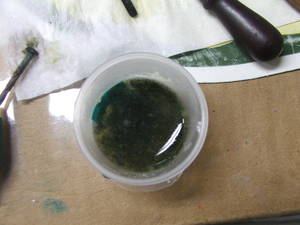Green rust could start a green revolution
Interview with
Sam Shaw from the University of Leeds has been using Diamond's beamlines to find out how rust could be used to benefit the environment.

Sam - Green rust is very similar to rust. It's an iron [the chemical symbol for which is Fe] oxide phase and it gets its name simply from its colour, but it has a slightly different chemistry from normal rust. It contains both Fe(II) and Fe(III), the two different oxidation states of iron and that's what gives it its green colour. Fe(II) produces blue compounds, Fe(III) is yellow and if you mix them together you get green. But the special properties of green rust are that it is able to immobilise particular contaminants by changing their chemical state and thereby reducing their impact on the environment; this could potentially be applied to remediate contaminated land sites.
Meera - What particular contaminants can it immobilise and where do you actually find green rust?
Sam - Well in terms of the contaminants, there's a wide range of inorganic contaminants from Chromium, which is a particular problem across the world. There was an industrial legacy of Chromium smelting in Europe and America which has left a lot of chromium waste. Also radionucleides like uranium, technetium, which are potentially hazardous, for example leaking from a nuclear waste repository, but also organic contaminants, for example trichloroethylene which is a widely distributed contaminant. In terms of where you get it in nature, it is extremely rare. Because it contains this Fe(II) component, it's very sensitive to air oxidation so while you might dig in the soil and find some green patches they will quickly turn brown as the Fe(II) is oxidized to Fe(III). This is one of the challenges of studying green rust; we have to mimic the conditions where it occurs by having very low oxygen levels to prevent oxidation. That is what we've been doing on the synchrotron.
Meera - So how do you set about recreating these conditions and then looking at the reactions of green rust here at the synchrotron?
Sam - Well what we've done is develop a reaction cell which can mimic the conditions of green rust formation in, say, a soil or potentially in a contaminated land site. To mimic the pH, the acidity or the alkaline nature of the solution and also the redox potential, so how oxidising or how reducing the environment is, so that's really controlled by how much oxygen is present in the system. By doing this, we can synthesise and form the green rust. Then, by flowing the solution containing the green rust as it forms through a capillary which is mounted on the synchrotron beam, we can characterise the formation reaction and the process by which the molecular structure of green rust is built.
Meera - So what is the structure of green rust and what have you been able to see about how it actually immobilises various contaminants?
Sam - Well we've been using x-ray scattering to characterise the formation of the structure and what we've found is by using in situ wide and small angle scattering x-ray on I22 here at Diamond, the formation reaction is a multi stage process where we get initial formation of poorly ordered, fairly amorphous nano-particles, and then the Fe2 absorbs onto their surface and this induces a re-crystallisation reaction which forms the green rust. We've also been adding contaminants, particularly uranium and selenium, to look at when these contaminants become immobilised during the formation process
Meera - So knowing this information, how could these contaminants be treated or immobilised? It seems green rust can only exist in very limited conditions, so given that, how is it then possible to create it to then decontaminate land?
Sam - That's a very good question and what we've learned using the synchrotron, is that we've really understood the geo-chemical conditions in which green rust is stable and from this we've been able to develop key formulations and recipes of green rust which we're beginning to use to immobilise particular contaminants. But it's true, the sensitive nature of the rust is a problem and we have gone some way to stabilising the green rust, but the future work we're doing will be to develop a more stable form with wider applications for the green rust materials.
Meera - Sam Shaw from the University of Leeds showing how understanding the science of rust on the nano-scale can help our environment on the global scale.










Comments
Add a comment